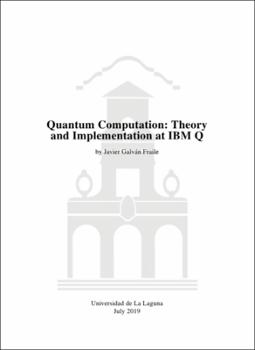Quantum computation: theory and implementation at IBM Q
Author
Galván Fraile, JavierDate
2019Abstract
This end of degree project constitutes an introduction to Quantum Computation. It presents a combination of theoretical concepts, mainly based in the
guidelines of “Quantum Computation and Quantum Information” of Michael
A. Nielsen & Isaac L. Chuang [NC02], and the implementation of some of
them at IBM’s online quantum computers [ibm18]. The aim is therefore to
realize a first approach to some basic concepts of Quantum Computation and
Quantum Information and put them in practice. Particularly, after the introduction of qubits and essential ideas about entanglement and multiple qubit
states, the 14-qubit quantum computer IBM Q Melbourne was employed to
generate both Bell and GHZ states. After that, a quantum/classical hybrid
algorithm known as Variational Quantum Eigensolver (VQE) [Com16] was
introduced as a crucial tool for the next two targets of the project. The first
of them consists on exhaustively analyzing and solving an optimization problem named Exact cover problem [Gal17]. The second one relates to find the
ground state of a bidimensional Ising model and study the evolution of bipartite entanglement, as measured by the von Neumann entropy, in the approach
of the system to its ground state. El presente trabajo de fin de grado constituye una introduccion a la Com- ´
putacion Cu ´ antica. En ´ el se presenta una combinaci ´ on de conceptos te ´ oricos, ´
basados principalmente en las directrices del libro “Quantum Computation
and Quantum Information” of Michael A. Nielsen & Isaac L. Chuang [NC02],
y la implemantacion de algunos de ellos en los ordenadores cu ´ anticos de ´
IBM disponibles en la nube [ibm18]. El objetivo del proyecto es, por tanto,
realizar una primera aproximacion a algunos de los conceptos b ´ asicos de la ´
Computacion Cu ´ antica e Informaci ´ on Cu ´ antica y ponerlos en pr ´ actica. En ´
particular, tras introducir el concepto de cubit y las ideas esenciales sobre en- ´
trelazamiento y estados formados por multiples cubits, el ordenador cu ´ antico ´
de 14 cubits ´ IBM Q Melbourne fue empleado para generar estados de Bell
y GHZ. Tras esto, se introdujo un algoritmo h´ıbrido clasico/cu ´ antico cono- ´
cido como Variational Quantum Eigensolver (VQE) [Com16], el cual es una
herramienta fundamental a la hora de cumplimentar los siguientes dos objetivos del proyecto. El primero de ellos consiste en el analisis exhaustivo y la ´
resolucion de un problema de optimizaci ´ on conocido como ´ Exact cover problem [Gal17]. El segundo se fundamenta en encontrar el estado fundamental de
un modelo de Ising bidimensional y estudiar la evolucion del entrelazamiento ´
bipartito, medido mediante la entrop´ıa de von Neumann, en la evolucion del ´
sistema hacia el estado fundamental.





